Squirrel
Small rodents found in woodlands worldwide!
Advertisement
Squirrel Scientific Classification
Read our Complete Guide to Classification of Animals.
Squirrel Conservation Status
Squirrel Facts
- Average Litter Size
- 3
- Lifestyle
- Solitary
- Favorite Food
- Fruit
- Type
- Mammal
- Slogan
- Small rodents found in woodlands worldwide!
View all of the Squirrel images!
A squirrel is a small rodent with a full and bushy tail, and they are found all over the world.
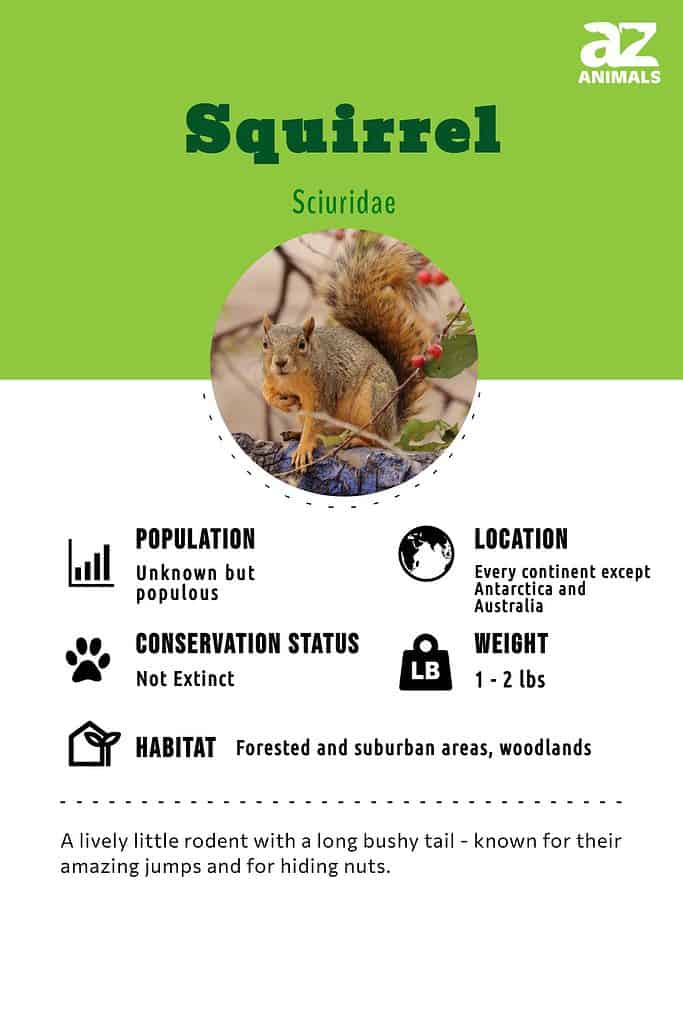
Types and Species
There are more than 200 species of squirrels all over the world. They are mostly categorized into three different types – ground squirrels, tree squirrels, and flying squirrels.
The various types are differentiated by their size and where they live. According to reports, squirrels are found on every continent except Antarctica and Australia. They go by the scientific name Sciuridae.
Some of the common types of squirrels include the Indian giant squirrel, the Western grey squirrel, and the American red squirrel. With the right habitat and care, you can also keep a squirrel as a pet.
In this article, we will focus mainly on tree squirrels – but the squirrel family is actually much larger than you think. Groundhogs, chipmunks and prairie dogs are also squirrels! More information about squirrel species can be found at the end of this article.
Evolution
The earliest fossil evidence for squirrels was found in western North America and dated to around 36 million years ago. Six million years later – fossil records indicate that squirrels appeared in Europe. During that time the Berring Strait land bridge provided passage for many different species – including squirrels – from North America. Squirrels show up in African fossil records shortly after it collided with Eurasia about 18-20 million years ago. After that, squirrels evolved and adapted to their diverse environments – into the over 200 species known today.
7 Incredible Squirrel Facts!
Here are some of the interesting facts about squirrels:
- There are over 200 species, and they can be found almost anywhere.
- A squirrel is a rodent, and they have a surprisingly trusting personality.
- Squirrels are planners! When the winter season nears, they gather and store food in different locations as a survival tactic.
- A squirrel is a very intelligent animal that uses different sounds to communicate with other squirrels.
- Along with these vocalizations, these animals will signal each other with their tails.
- Squirrels do not like some smells and are repellent to them, like white pepper, garlic, and black pepper.
- The most commonly used term for a group or gathering of squirrels is a scurry.
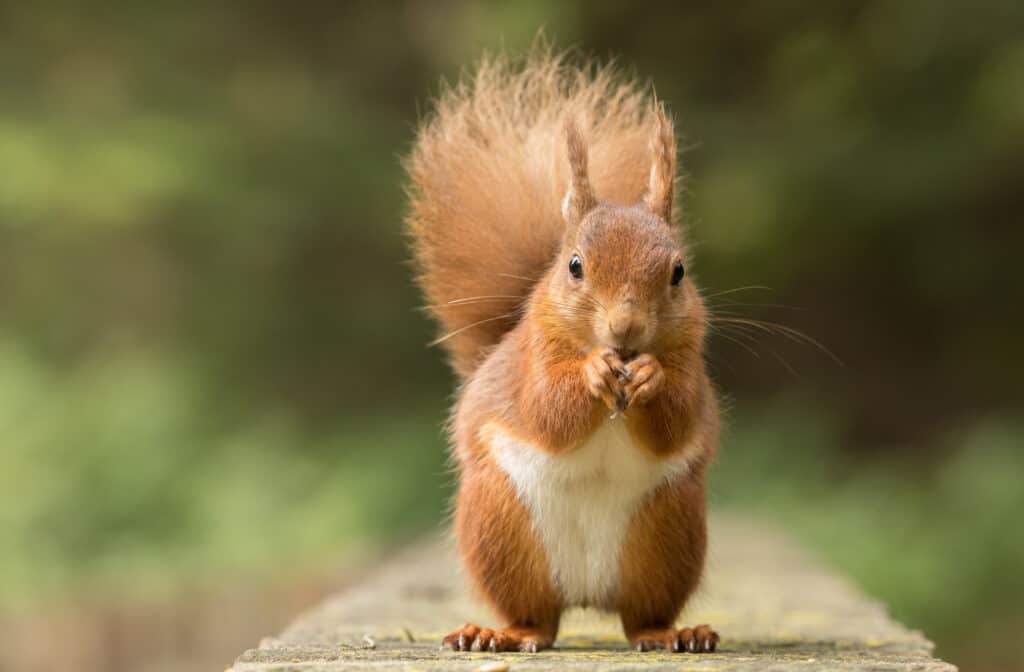
Squirrels are small, nimble rodents with bushy tails.
©Andrew Swinbank/Shutterstock.com
Scientific Name
Squirrels go by the scientific name Sciuridae and belong to the kingdom Animalia and phylum Chordata. Their class is called Mammalia and the order is called Rodentia. The suborder is called Sciuromorpha, and the family is called Sciuridea too, just like the scientific name.
The word Sciuridae is from the Latin word Sciurus, which means squirrel. The Latin root comes from a combination of two Greek words – skia (shade) and oura (tail).
Appearance
These animals are small-sized, nimble rodents. Their bodies are slender, and they have large eyes and bushy tails. Their fur is short and silky and is very soft too. However, the thickness of the fur depends as well as varies from species to species. The fur comes in a variety of colors including grey, brown, yellow, red, black, and white. The color of the squirrels also depends on the type of squirrel.
Most species have small yet pointed ears with tiny, sharp claws, giving them the leverage that they need to climb trees quickly and with ease. The smallest squirrel is only 10 cm long while some of the largest squirrels in the world can have bodies of 30 to 50 cm in size. Their tails are even bigger, reaching a length of up to 60 cm in some species.
The average squirrel weighs 1 -1.5 pounds. The Indian giant squirrel is about 1.5 – 2 kg (3.3 – 4.4 lbs), featuring beautiful rust and black fur coat. Interestingly, a solid black coat is considered very rare in squirrels.
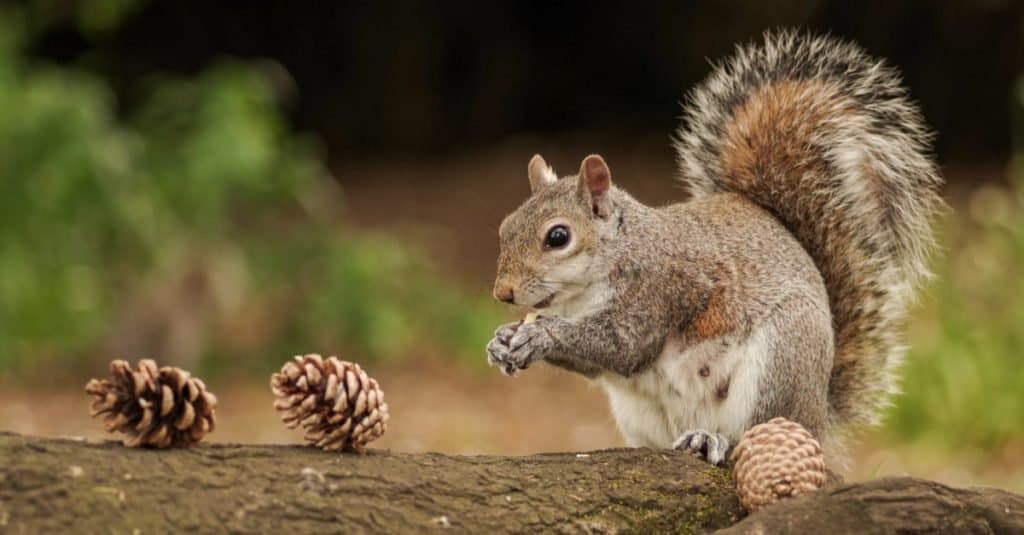
Squirrels prefer to store nuts in a variety of hiding places and tend to remember where they were hidden.
©PhotoEvtim/Shutterstock.com
Behavior
These rodents are warm and fuzzy animals, easily giving over their trust to humans. They can also be kept as a pet. They can come to eat from your hand if they trust you enough. They are also very intelligent, and their brain is known to be dedicated to visual functions.
As trusting as they may be, they might stare at a person to judge if the person is safe or unsafe for them. They will quickly climb up a tree in case they sense any danger at all. They are also known to be noisy animals and vocalize their thoughts by chattering, barking, purring, and screaming – especially during mating season.
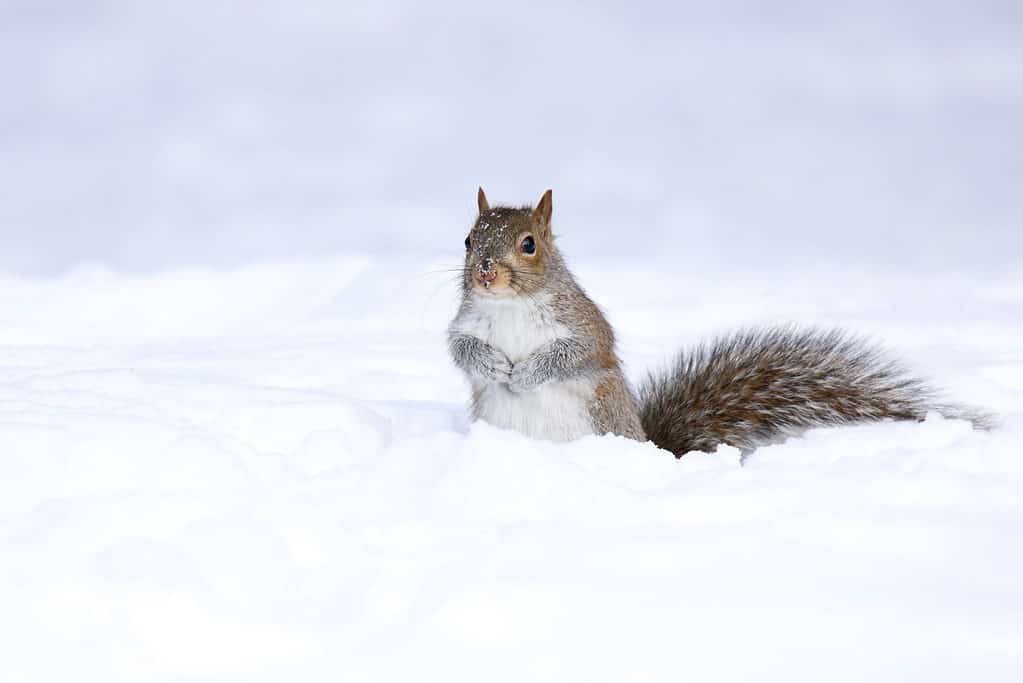
Eastern Gray Squirrel is out looking for food in winter snow.
©iStock.com/suefeldberg
To warn others of impending danger or potential suspicion, these rodents will wag their tails. They also prepare well for the winter when food may not be as plentiful. They prefer to store nuts, seeds, and other food items, but they won’t store everything in the same place. Instead, they choose different spots so that they can go back to them when the weather conditions turn harsh. They usually dig burros and rest in them to protect themselves from the cold as well as harsh conditions.
These animals are most active during the day and during the dawn and at dusk. Flying squirrels, on the other hand, are known to be usually active during the night. They do not like the smell of white pepper, black pepper, and garlic, giving you an easy and non-toxic repellent to keep these critters away.
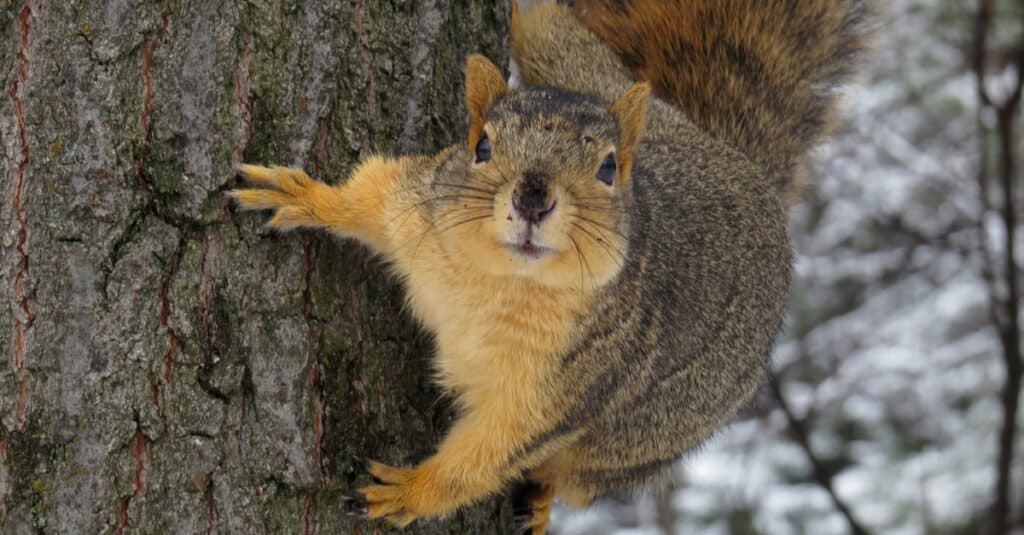
You can usually spot a squirrel wherever there are trees.
©Nico Giuliani/Shutterstock.com
Habitat
Reports suggest that these animals can be found on every continent except Australia and Antarctica. Different species can be found in different areas of the world. However, these animals can be found mostly in mature or nearly mature forests, especially in woodland areas (including the Indian giant squirrel).
They usually nest on walnut, oak, pecan, hickory, maple, elm, and mulberry trees, giving them plenty of places to rest. Tree squirrels especially live in wooded areas and (as their name suggests) prefer living in the trees. Meanwhile, ground squirrels live on the ground, digging tunnels and burros to travel underground. These burrows are also used to nest during the winter season.
These animals create their nests themselves with the help of twigs and leaves that they go around collecting. The inside lining of their nests is grass and leaves. Their nests are called dreys and they usually place along branches or on buildings.
Some species might not end up making their own nests and could temporarily take shelter in holes and stumps. There are usually two types of nests that the animals make. They either make open nests that are used for sleeping or covered ones that are used for birthing as well as raising babies.
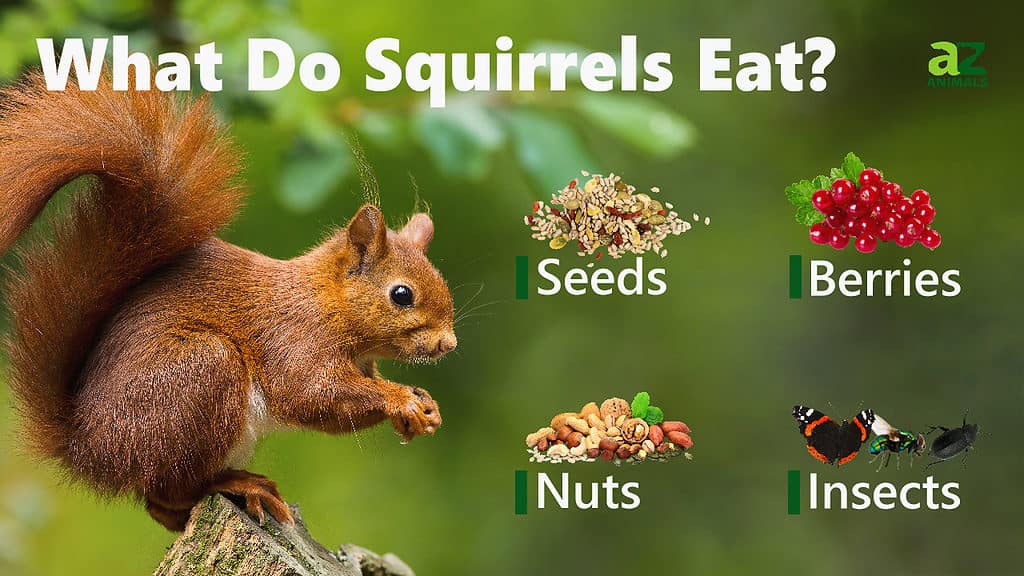
Diet
Squirrels primarily eat seeds, nuts, fungi, and fruit. Apart from that they also feed on other plant matter. Some species are also omnivorous in times when food is not plentiful. However, they don’t feed on other mammals and are not so predatory. Instead, these animals take to feeding on eggs, insects, and some small invertebrates. For a complete list of foods squirrels eat, check out our “What Do Squirrels Eat?” page.
Predators and Threats
These rodents face threats from human activities like industrialization and deforestation which ultimately leads to their habitat loss and eradicates their population slowly. Habitat loss is also facilitated by urbanization as well as wildfires. There are also certain plants that threaten the natural habitat of the animal.
The Western grey squirrel was earlier considered a threatened species due to a disease that took much of its population. It also was put at risk for the many road accidents that killed these animals. The population has since recovered.
What Eats Squirrels?
Some of the common predators of these animals include red foxes, domestic cats, wild cats, dogs, badgers, polecats, and weasels. Large carnivorous birds like eagles also prey on squirrels.
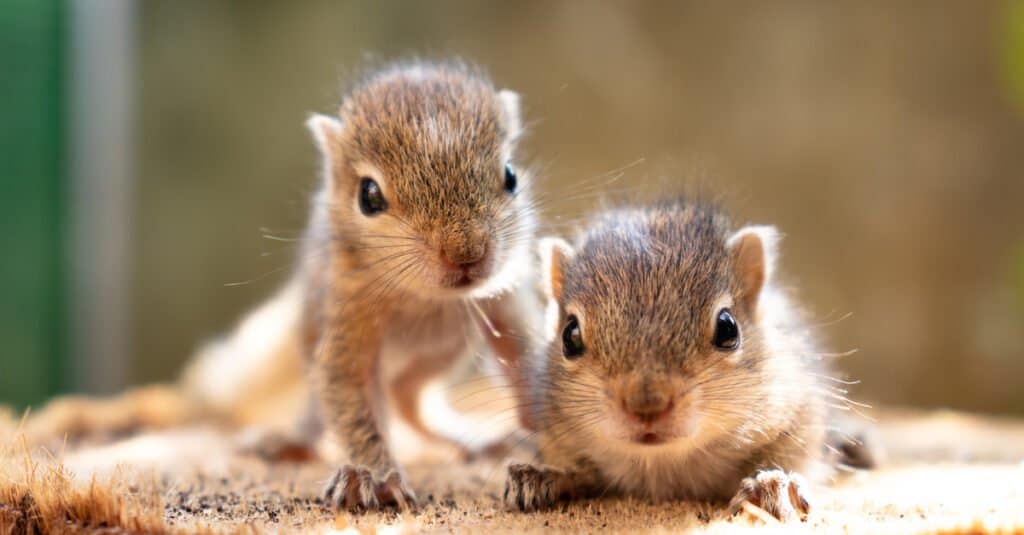
Squirrel babies are born blind and hairless and aren’t weaned until they are 6-10 weeks old.
©Nilanka Sampath/Shutterstock.com
Reproduction, Babies, and Lifespan
These animals breed once or twice every year. They have a gestation period of 3 to 6 weeks, but it depends on the particular species. This rodent can mate as early as 1 year old, eventually having two litters of young. One of the litters is typically born at the end of spring, while the other is born at the end of summertime.
The babies open their eyes at 4 weeks of age. When they are 6 weeks old, they usually start venturing out of their nests. The babies are born blind and hairless, not weaning from their mothers until they are about 6 to 10 weeks old. Baby squirrels are known to thrive most easily when they have the care of their mothers, giving them the best chance of survival.
The lifespan of the animal varies from species to species. In the wild, the lifespan can range from 5 to 10 years.
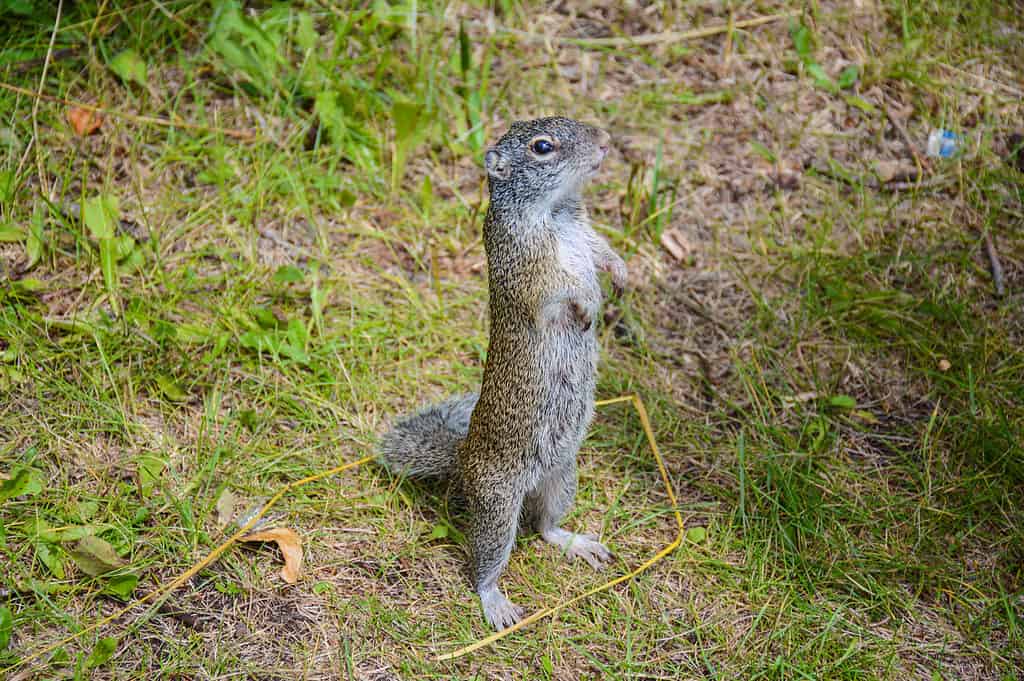
Squirrels are always on the alert for danger and are quick to warn others of the threat vocally.
©iStock.com/Jeff439
Population
While the exact population of these animals that exist around the world is unknown, there are more than 200 species of squirrels. Most of them can be divided up by their method of travel, including ground squirrels, tree squirrels, and flying squirrels. However, the latter actually glides through the air, rather than flying.
Though the Western-grey squirrel was considered a threatened species at one time, the population has recovered.
More Squirrel Species
There are over 200 species of squirrels, here are a few of those:
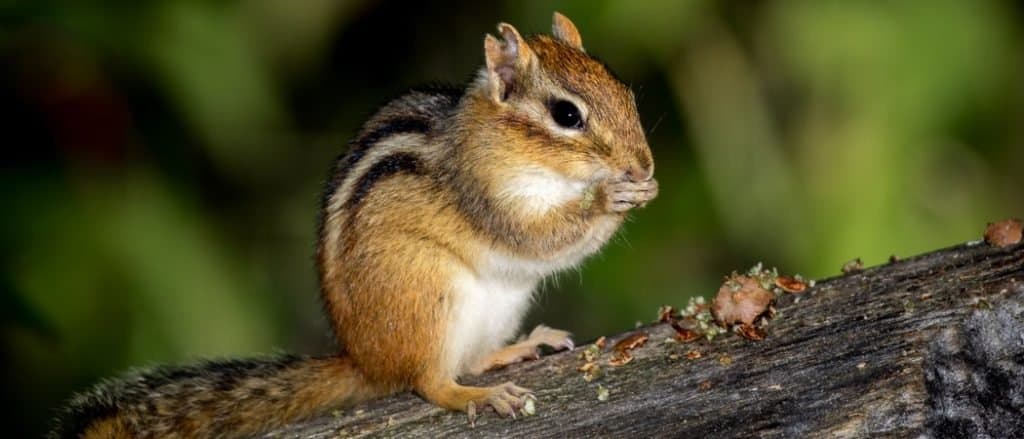
Chipmunks are tiny ground squirrels.
©RT Images/Shutterstock.com
- Chipmunks – Small, striped rodents found in North America. The Siberian chipmunk is found in Asia. These little ground squirrels play an important role in forest ecosystems by harvesting and distributing tree seeds. They also help trees by eating fungi and by dispersing truffle spores.
- Western grey squirrels – Can be found in Washington, Oregon, California and Nevada.
- Red – A species of tree squirrel common throughout Europe and Asia.
- Fox – Larger than the more common grey squirrel, these squirrels can be found in the eastern, central and southeastern portions of the United States.
- American Red – Also known as “pine squirrel”, the American Red can be found anywhere in the United States that has an abundance of conifer trees.
- Southern Flying – A flying squirrel that can be found in the northern and southern sections of the eastern United States.
- Northern Flying – This little flying squirrel is smaller than it’s southern cousin and resides in the northwestern United States.
- Douglas – Found on Pacific coastal states in the U.S., the Douglas is the other “pine squirrel” – along with the American Red.
- Abert’s – This unusual squirrel is dark grey with a white belly and tail. It also has elongated, black-tipped ears and can be found in Arizona, New Mexico and Colorado.
- White-tailed antelope – These little ground squirrels look like their chipmunk cousins – except their stripes end at their necks. They can be found in New Mexico, Colorado, Oregon, Arizona, Idaho, Utah, Nevada and southern California.
- Black-tailed prairie dog – Native to the grasslands of North America, these little members of the squirrel family inhabit shortgrass prairies where they live in vast underground burrows. They have a matriarchial social structure where everyone chips in to help the colony. Prairie dogs have an impressive set of vocalizations that they use to send messages to each other.
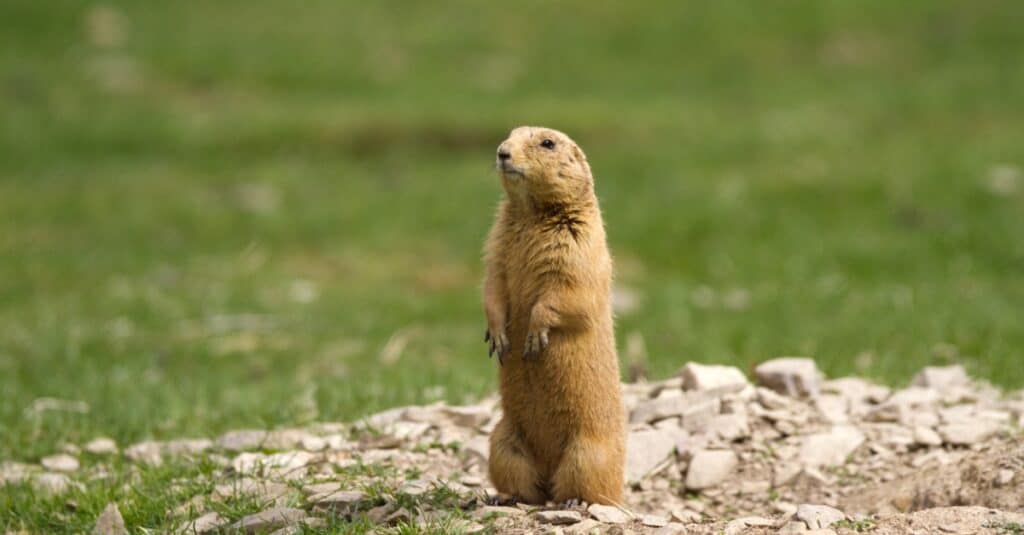
The black-tailed prairie dog is the most common species of a prairie dog to eat their young.
©iStock.com/ViktorCap
- Indian giant – Also known as Malabar Giant squirrel, this large multi-colored tree squirrel lives in forests and woodlands in India. One of the world’s largest squirrels, the Indian giant can weigh up to 4 pounds and comes in a one, two or three-toned color scheme. Colors are whitish, creamy beige, buff, tan, rust, reddish-maroon, brown, dark seal brown or black.
- Texas antelope – These tiny Texans look like chipmunks but with one difference – their stripes don’t extend to their heads and their tails are frequently held over their backs.
- Prevost’s squirrel – Also called, Asian tri-colored squirrel, this colorful little rodent can be found in the forests of the Thai-Malay Penninsula, Sumatra, Borneo and nearby smaller islands. Their fur has three distinct bands of jet-black, white and reddish-brown.
- Arizona grey – A grey tree squirrel who dwells in the canyons and valleys surrounded by mixed forests in eastern Arizona and northern Mexico.
- Mohave ground – These little ground squirrels can only be found in the Mohave Dessert in California. They are known for the cute little “peep” sound they make.
- Palla’s – Also known as the red-bellied tree squirrel, this grey and red squirrel is native to China, India, and Southeast Asia.
- Northern Idaho ground – This little ground squirrel is considered threatened. Smaller than most ground squirrels, its fur is grayish brown with reddish brown spots. It has a short tail, tan feet and ears, and a creamy white eye ring. This rare squirrel eats large quantities of grass seed, stems and leaves.
- Smith’s bush – Also known as the yellow-footed tree squirrel, this squirrel is native to woodlands of the southern Afrotropics. Its coloration varies with its range – some being pale grey – some pale brown. Its head and legs are a dark rusty color. Their chests tend to be yellowish to buff.
- Groundhog – Also known as woodchucks, groundhogs are members of a subspecies of the squirrel family known as marmots. They are extremely intelligent, forming complex social networks, form kinship with their young and communicate vocally. They work together to burrow tunnels where they sleep, hibernate and live. These large rodents live all over the eastern United States, across Canada and into Alaska.
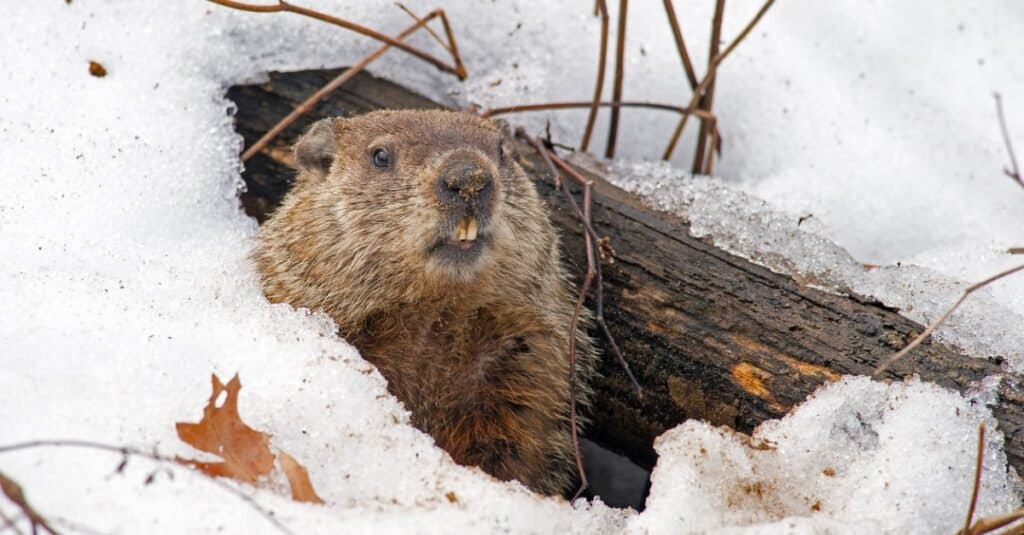
Groundhog coming out of burrow in the snow
©iStock.com/BrianEKushner
Other squirrel species are:
Cape ground squirrel, Least pygmy, Grizzled giant, Wyoming ground, Humbolt’s flying, Rock squirrel, Varigated, Mexican grey, Round-tailed ground, Belding’s ground, Merriam’s ground, Piute ground, Yellow-pine chipmunk, Yellow-bellied marmot, Thirteen-lined ground, Columbian ground, Washington ground, Richmond’s, Allen’s, Caucasian, Collies, Deppe’s, Fiery, Black Giant, Mexican fox, Red-tailed, Japanese and Peter’s.
In the Zoo
Squirrels can be kept in zoos, though an experienced owner can also keep them as a pet. Zoos in nearly every state have exhibited squirrels, making them easy to find. However, if you don’t want to go to the zoo, you might just need to venture to a local forest to find them.
Similar to Squirrels
View all 293 animals that start with SSquirrel FAQs (Frequently Asked Questions)
Are Squirrels herbivores, carnivores, or omnivores?
While the usual diet of a squirrel is made up of nuts, seeds, and fruits, some of them are also omnivorous and can eat eggs, insects, and other small vertebrates when the food is scarce.
What Kingdom do Squirrels belong to?
Squirrels belong to the Kingdom Animalia.
What phylum do Squirrels belong to?
Squirrels belong to the phylum Chordata.
What class do Squirrels belong to?
Squirrels belong to the class Mammalia.
What family do Squirrels belong to?
Squirrels belong to the family Sciuridae.
What order do Squirrels belong to?
Squirrels belong to the order Rodentia.
What type of covering do Squirrels have?
Squirrels are covered in Fur.
In what type of habitat do Squirrels live?
Squirrels live in woodlands and dense forests.
What is the main prey for Squirrels?
Squirrels eat fruit, seeds, and insects.
What are some predators of Squirrels?
Predators of Squirrels include snakes, coyotes, and weasels.
How many babies do Squirrels have?
The average number of babies a Squirrel has is 3.
What is an interesting fact about Squirrels?
Squirrels are small rodents found in woodlands worldwide!
What is the scientific name for the Squirrel?
The scientific name for the Squirrel is Sciuridae.
What is the lifespan of a Squirrel?
Squirrels can live for 2 to 8 years.
How fast is a Squirrel?
A Squirrel can travel at speeds of up to 16 miles per hour.
What do you feed a baby squirrel?
You can feed the squirrel baby diluted milk, a few drops of curd, and glucose.
What does squirrel poop look like?
Squirrel poop largely resembles rat poop. However, they are larger, barrel-shaped pellets and are dark-brown in color.
What do squirrels hate the most?
Squirrels are repellent towards smells of white pepper, black pepper, and garlic – they find them very unpleasant.
What does it mean when a squirrel stare at you?
If a squirrel is staring at you, it is highly possible that it is judging if you are safe or unsafe. If it finds anything suspicious, the squirrel can quickly climb u the tree to protect itself.
Is a squirrel dangerous?
Squirrels are affectionate and are very trusting. If they trust you, they can come to eat from your hand as well. However, whether or not they are dangerous is unclear. Some say that they do carry diseases that they can pass to humans. Therefore, it is always better to stay protected and take precautions while coming in contact with squirrels.
What is the difference between a squirrel poop and a rat poop?
The major differences between squirrel poop vs rat poop include size, shape, and color. Rat poop is both longer and thicker than squirrel poop. However, the two are relatively close in size, so it may seem similar to the untrained eye.
What is the difference between a bay rat and a baby squirrel?
The greatest differences between a newborn squirrel vs rat are their size, head shape, and toenail color. A newborn squirrel is likely to be larger than a rat, and it will initially weigh more than a rat.
What is the difference between a ground squirrel and a tree squirrel?
The greatest differences between a ground squirrel vs tree squirrel are their size, color, and habitat. Ground squirrels are larger than tree squirrels on the whole. Ground squirrels can reach weights of 18lbs and lengths of nearly 3ft on average, but tree squirrels only tip the scales at a quarter of that weight.
What is the difference between a gopher and a squirrel?
The main differences between a gopher and a squirrel include their appearance, diet, habitat, behavior, and damage.
Thank you for reading! Have some feedback for us? Contact the AZ Animals editorial team.
Sources
- Live Science, Available here: https://www.livescience.com/28182-squirrels.html
- One Kind Planet, Available here: https://onekindplanet.org/animal/squirrel/
- Pest World, Available here: https://www.pestworld.org/news-hub/pest-articles/squirrels-101/
- Animals Network, Available here: https://animals.net/squirrel/
- The Wildlife Center of Virginia, Available here: https://www.wildlifecenter.org/baby-squirrels
- The Big Green K, Available here: https://thebiggreenk.com/keep-squirrels-away/
- Oxford Academic, Available here: https://academic.oup.com/mspecies/article/46/914/88/2643021

















